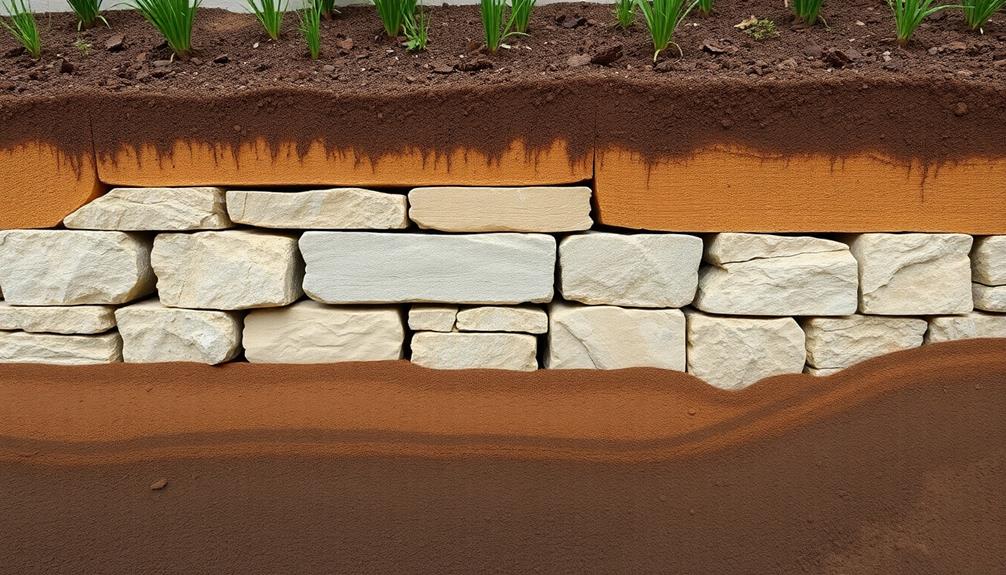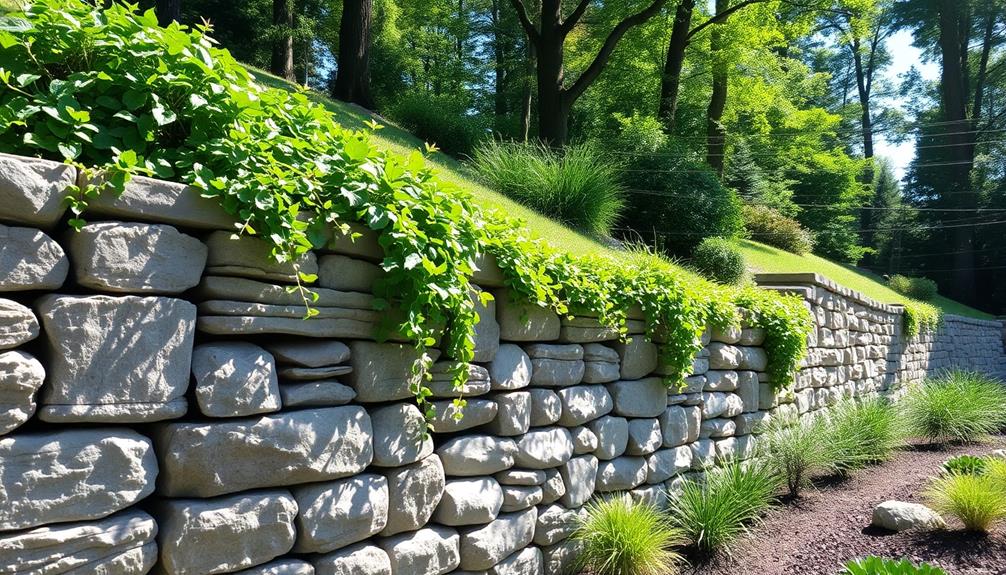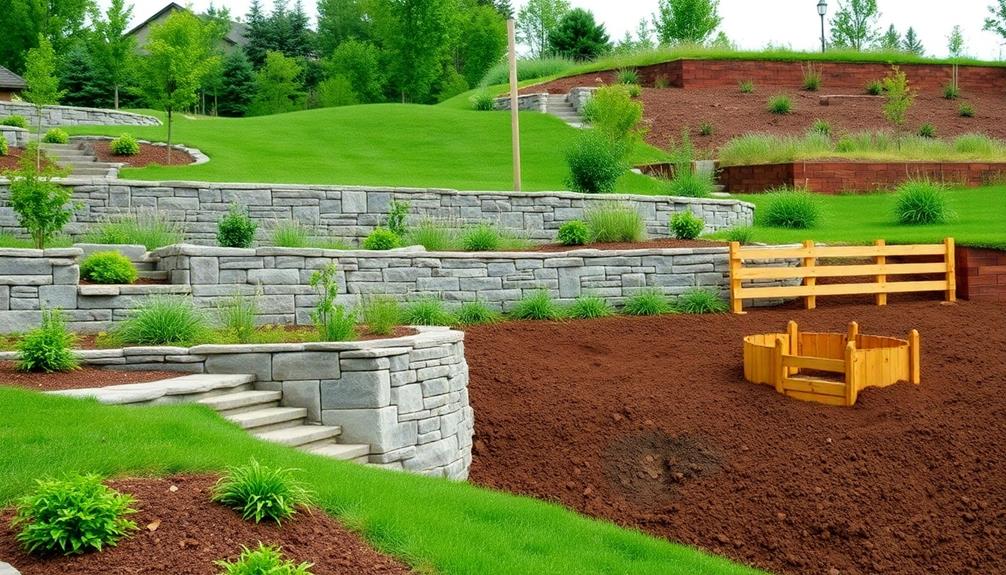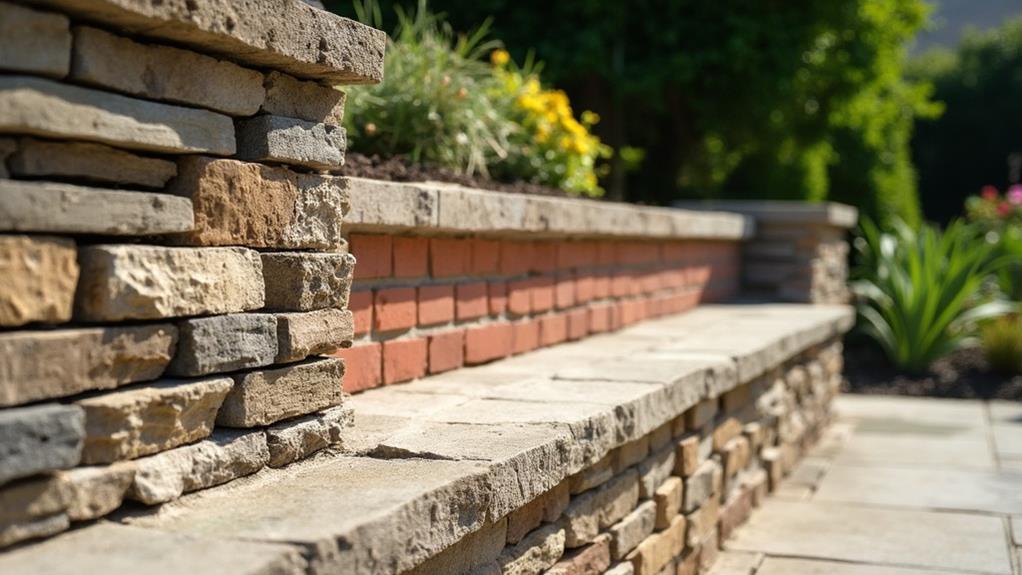Choosing the appropriate materials for your retaining wall necessitates examining several key elements to guarantee lasting functionality and aesthetic integration. Consider the durability and weather resistance of options like natural stone, concrete, or treated lumber, tailored to match your property's architectural style. Assess ease of installation and maintenance alongside cost-effectiveness to align with your budget. Evaluate the specific environmental circumstances, including soil composition and local climatic conditions, which may influence the structural integrity. Consulting with landscape architects can guide material selection and compliance with regulatory codes. Exploring these aspects more deeply reveals the nuances involved in material choice.
Table of Contents
ToggleWalls Contractor Highlights
- Assess durability and resilience to environmental stressors for long-lasting retention.
- Ensure material compatibility with property architecture and local aesthetics.
- Consider ease of installation and low maintenance requirements for practical application.
- Evaluate cost-effectiveness and budget alignment of chosen materials.
- Consult professionals to align material choice with site-specific conditions and regulations.
What Defines Retaining Walls?

Retaining walls are critical structures designed to hold back soil and provide stability to landscapes. They are often employed to combat erosion and manage landscape elevation variations.
These walls vary in types, such as gravity, cantilevered, and anchored systems, each serving distinct functions based on the terrain and load requirements. Additionally, retaining walls create usable areas for gardening, patios, parking pads, and more, enhancing both the functionality and aesthetics of a property.
Furthermore, successful implementation of retaining walls necessitates adherence to specific structural requirements, ensuring they withstand hydrostatic pressures and environmental stressors over time.
Purpose of Retaining Walls
The very essence of retaining walls lies in their fundamental purpose, which is to provide structural support by holding back soil or earth. This essential function is integral to maintaining the integrity of landscapes, particularly where elevation changes are involved.
Retaining walls create level areas in sloped terrains and prevent soil erosion, ultimately safeguarding properties and infrastructure from potential damage. As stewards of nature's forces, retaining walls empower builders and homeowners alike to sculpt the land in ways that were previously inaccessible or unsafe.
These structures are often more than mere barriers—they are significant elements in landscape design, offering aesthetical value while serving a critical geomorphic function. The volition to display an inviting outdoor space that harmonizes with nature finds its expression through a well-constructed retaining wall.
This marriage of form and function resonates with those who yearn for cohesiveness between their built environment and the land, creating a unified community that thrives within and alongside the natural beauty it preserves.
At their core, retaining walls symbolize strength, resilience, and harmony, reflecting the collective endeavor to coexist with our surroundings while reshaping them responsibly, underscoring their indispensable role in both form and function.
Types and Functions
A diverse array of retaining wall types exists, each designed with specific functionalities to address varied landscaping needs and engineering challenges. These structures are not merely functional but serve as a symbol to thoughtful planning and design, ensuring landscapes remain both aesthetically pleasing and structurally sound. Understanding the different types can greatly enhance the sense of belonging and confidence in a community's shared spaces.
- Gravity Walls: Utilizing their immense weight to resist pressure, gravity walls, typically constructed with concrete or stone, embody a robust presence. They are ideal for low-height applications where stability and charm are equally valued.
- Cantilevered Walls: Often seen in large-scale commercial or residential projects, these walls rely on their T-shaped footing to provide support, extending like an arm into the earth for enhanced stability. Their design reflects a sophisticated interaction between soil mechanics and engineering principles.
- Segmental Retaining Walls: Composed of interlocking concrete units, these walls offer flexibility in design and function, often gracing gardens and smaller projects with their ease of installation and customizable aesthetics.
In capturing the essence of these varied types, one appreciates how each contributes to harmony and stability within their environment—a harmony that resonates with our innate desire to be part of something enduring and dependable.
Structural Requirements
Understanding the inherent characteristics that define retaining walls highlights their indispensable role in maintaining landscape stability and functionality. At their core, retaining walls are engineered systems designed to hold back soil and prevent erosion in areas where elevation changes are present. These walls are constructed to withstand lateral pressure from the soil or other materials that they support, thus preserving the structural integrity of a landscaped area.
The key structural requirements of retaining walls are determined by factors such as height, loading conditions, soil type, and drainage capacity. Height dictates the materials and design methodology, as taller walls necessitate more robust structures and materials such as reinforced concrete or masonry blocks. Loading conditions, including live loads from vehicles or static loads, influence the design calculations to ensure safety and durability.
Soil type plays an essential role, as different soils exert varying pressures, requiring tailored construction techniques. Proper drainage is another critical component, as inadequate water management can lead to wall failure due to hydrostatic pressure. Consequently, integrating drainage solutions like weep holes or geotextiles is paramount. By recognizing these structural requirements, one can select materials that not only enhance appearance but also guarantee safety and longevity.
Benefits

Selecting the right materials for a retaining wall offers numerous advantages, including enhanced soil stability, which prevents erosion and maintains the integrity of the landscape. Boulder retaining walls, for example, are known for their cost-effectiveness and long-lasting nature, making them an excellent choice for a durable solution.
Additionally, well-designed retaining walls can substantially increase property value by adding aesthetic appeal and functional benefits, such as improved water drainage that mitigates flooding risks. Correspondingly, a wide range of versatile design options allows homeowners and developers to create structures that seamlessly integrate with the surrounding environment while fulfilling specific architectural visions.
Enhanced Soil Stability
One of the central benefits of a well-constructed retaining wall is its role in enhancing soil stability. Retaining walls are specifically designed to counteract the lateral pressure exerted by soil, which can cause erosion or landslides if left unchecked. By selecting the appropriate materials, retaining walls can effectively provide both structural support and aesthetic appeal, while seamlessly integrating into the existing landscape.
Safeguarding soil stability guarantees that the environment remains safe and sustainable, preventing potential geological issues that could disrupt harmony within the community.
- Protect Your Home: A robust retaining wall can shield your home and property from soil movement, reducing the risk of damage during heavy rains or earthquakes. Feeling secure in your own space fosters a sense of belonging and peace of mind.
- Environmental Harmony: By preserving the natural landscape, retaining walls help maintain biodiversity, ensuring that native plants and wildlife continue to thrive, nurturing a sense of connection to the environment.
- Long-term Sustainability: Choosing quality materials for your retaining wall promotes durability, reducing the need for frequent maintenance and repairs, which can be both costly and disruptive to community life.
Increased Property Value
Regularly enhancing a property's features, such as by constructing a well-designed retaining wall, can extensively boost its market value. A retaining wall not only serves practical purposes but also adds distinct aesthetic appeal, creating an attractive and functional outdoor space that potential buyers often find appealing. Whether built from natural stone, brick, or timber, a retaining wall can be a defining feature that enhances the overall landscape design, offering the property a cohesive and sophisticated appearance. This visual enhancement is essential for cultivating a strong first impression, often resulting in higher appraisal values.
Furthermore, retaining walls can dramatically expand usable outdoor areas, transforming sloped terrains into versatile spaces for gardens, patios, or seating areas. This increased functionality adds demonstrable value by maximizing the utility of the land, appealing to prospective buyers who value both visual appeal and practicality. The selection of high-quality materials further underscores this value by ensuring the wall's longevity and durability, thereby reducing maintenance concerns and echoing a commitment to quality and attention to detail. Consequently, investing in the right materials for a retaining wall not only fortifies the property but also aligns with the desire of homeowners to create inviting, well-maintained environments that foster a sense of belonging and community.
Improved Water Drainage
In addition to enhancing property value, a well-engineered retaining wall offers significant benefits in managing water drainage. By selecting the right materials, these structures substantially improve the drainage efficiency, guaranteeing that your landscape remains both beautiful and functional. Retaining walls serve as vital components in diverting excess water, thereby preventing soil erosion and reducing the risk of structural damage to your property.
Consider the following advantages when choosing materials for improved drainage:
- Optimal Soil Stability: Proper drainage enhances soil stability by reducing pressure on the wall itself and maintaining the integrity of your landscape over time. Through meticulous planning and the use of permeable materials, water is directed efficiently away from the soil, promoting a robust and sustainable garden environment.
- Reduced Maintenance: Materials that facilitate adequate drainage diminish the need for frequent maintenance. By preventing water accumulation, you guarantee the longevity of your wall and surrounding structures, freeing you from relentless upkeep.
- Enhanced Environmental Harmony: An effective drainage system promotes harmony between your landscape and the surrounding ecosystem. By allowing water to flow naturally and safely, you contribute to the ecological balance, fostering a sense of belonging with nature.
Versatile Design Options
Retaining walls introduce a domain of versatile design options that cater to both aesthetic preferences and functional needs. As integral components of landscape architecture, retaining walls can considerably enhance both the beauty and utility of a space. The selection of materials greatly influences the overall design outcome, offering various combinations of texture, color, and form to create a cohesive, harmonious outdoor environment. With choices ranging from natural stone and concrete to timber and gabions, property owners are empowered to realize their vision, aligning the wall's design with the existing architectural elements and the landscape's natural contours.
Each material carries its unique set of benefits, which extends beyond visual appeal to include durability and ease of maintenance. For instance, natural stone offers timeless beauty and strength, blending seamlessly with nature, while concrete blocks provide flexibility in design through modular assembly and a wide palette of finishes. Timber offers a rustic charm that can soften hardscapes, whereas gabions demonstrate structural creativity and environmental integration. These diverse options allow homeowners to craft spaces that foster a sense of belonging, inviting inhabitants and guests alike to appreciate the thoughtful integration of design and function in their outdoor areas.
Design and Construction Considerations

When designing and constructing a retaining wall, it is indispensable to evaluate the soil type, as it profoundly impacts the choice of materials and the wall's structural integrity. The height of the wall presents another challenge, necessitating precise engineering calculations to guarantee stability and compliance with local regulations. Additionally, incorporating an effective drainage system is paramount to minimizing hydrostatic pressure, which can otherwise undermine the wall's longevity.
| Consideration | Importance |
|---|---|
| Soil Type | Influences material choice and structural stability |
| Wall Height | Requires accurate calculations for stability and compliance |
| Drainage System | Reduces hydrostatic pressure to ensure wall longevity |
Soil Type Importance
Understanding the significance of soil type is paramount when designing and constructing a retaining wall. The soil plays a pivotal role in determining the structural integrity and longevity of the wall, particularly because different soils interact uniquely with water and pressure.
Properly evaluating the soil composition surrounding the proposed site is an essential first step. A detailed analysis helps identify whether the soil is clay, silt, sand, or a mixture, each presenting specific challenges and benefits related to drainage, compactness, and load-bearing capacity.
- Safety Concerns: Soils like expansive clay can retain water and swell, posing a risk of dislodging the wall over time, which can lead to costly repairs or even failure of the structure.
- Environmental Resilience: The surrounding environment must be considered; for example, sandy soils, though excellent for drainage, may require reinforcement to prevent instability during heavy rainfall.
- Community Aesthetics: By acknowledging the type of soil, one can better match the materials and design to the local landscape, creating a harmonious look that aligns with neighborly expectations and community standards.
Incorporating soil type considerations guarantees the retaining wall not only stands firm but also integrates seamlessly into its environment, fostering a sense of belonging within the community.
Wall Height Constraints
Designing for wall height constraints is a critical aspect of both the design and construction phases of a retaining wall. The height of a retaining wall determines its structural demands, directly affecting the materials required and the methods used in construction. Taller walls must endure significant lateral earth pressure and external loads, necessitating higher-grade materials and possibly more complex construction techniques. Materials such as reinforced concrete or interlocking blocks may be chosen for their strength and stability, especially in walls exceeding four feet, where safety and durability are paramount.
Additionally, considering the potential impact of local regulations and ordinances is essential, as these often dictate maximum wall heights and associated structural requirements to guarantee community safety. A thorough understanding of these constraints fosters a sense of trust with your neighbors and local authorities. Incorporating engineering expertise confirms that your wall is not only compliant but also enhances the landscape, harmonizing with its surroundings.
Ultimately, thoughtful planning and material selection aligned with height constraints not only avert structural failure but also improve the aesthetic and functional value of your property, nurturing a sense of community pride and personal satisfaction.
Drainage System Planning
In the domain of retaining wall projects, effective drainage system planning holds equal importance to material selection and height considerations. Proper drainage is essential, as it helps to reduce hydrostatic pressure behind the wall, mitigating the risk of water damage and structural failure.
A carefully designed drainage system can instill a sense of security and longevity, thereby fostering a sense of community among all stakeholders involved. When planning your drainage system, consider the following key elements:
- Perforated Drainage Pipes: Place these pipes at the base of the wall to efficiently direct water away, ensuring the retention of structural integrity and fostering a safe, long-standing environment.
- Gravel or Aggregate Backfill: Utilize backfill materials to facilitate water movement toward drains, reducing excess pressure behind the wall and evoking a shared responsibility in minimizing environmental impact.
- Filter Fabric: Implement this layer between the soil and backfill to prevent clogging, which emphasizes a commitment to functional and sustainable design, encouraging collective maintenance efforts.
Planning an effective drainage system is fundamental not only for the wall's stability but also in creating a unified effort in construction excellence, thereby nurturing an enduring community-based approach to landscape architecture.
Walls Contractor FAQ
What Is the Average Cost of Materials for a Retaining Wall?
The average cost of materials for a retaining wall typically ranges from $15 to $30 per square foot, inclusive of materials like concrete, stone, or wood. Pricing is influenced by local market rates and specific project requirements.
How Do I Ensure the Materials Are Environmentally Friendly?
To guarantee your materials are environmentally friendly, select locally sourced, sustainable products, and verify certifications such as ISO 14001. Engage with trusted suppliers committed to eco-friendly practices to contribute positively to both your community and the environment.
Can I Use Recycled Materials for My Retaining Wall?
Using recycled materials for your retaining wall is feasible and aligns with sustainable practices. Evaluate local building codes, material longevity, and environmental impact to guarantee these materials meet community standards and effectively contribute to eco-conscious construction efforts.
How Do I Maintain the Materials Over Time?
To maintain retaining wall materials effectively, routinely inspect for damage, clean surfaces to prevent build-up, and address drainage issues promptly. Conduct annual maintenance, applying suitable sealants and repairs as required. Consistent care guarantees continued structural integrity and aesthetic appeal.
What Are Common Mistakes to Avoid When Selecting Wall Materials?
When selecting materials for your wall, common mistakes include neglecting climate considerations, underestimating load requirements, ignoring drainage needs, and overlooking maintenance demands. By addressing these factors, you guarantee long-term stability and aesthetic harmony, fostering a sense of belonging.







